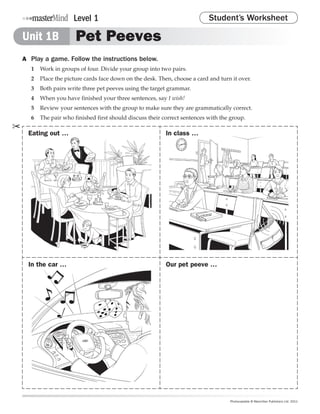M m1 resource_activity_unit_1b
- 1. Level 1 Student°Øs Worksheet Unit 1B Pet Peeves A Play a game. Follow the instructions below. 1 Work in groups of four. Divide your group into two pairs. 2 Place the picture cards face down on the desk. Then, choose a card and turn it over. 3 Both pairs write three pet peeves using the target grammar. 4 When you have finished your three sentences, say I wish! 5 Review your sentences with the group to make sure they are grammatically correct. 6 The pair who finished first should discuss their correct sentences with the group. ? Eating out °≠ In class °≠ In the car °≠ Our pet peeve °≠ Photocopiable ? Macmillan Publishers Ltd. 2011
- 2. Level 1 Unit 1B Notes Teacher°Øs Teacher°Øs Notes Pet Peeves Objective: to practice writing about and discussing annoying behavior Time: 30®C40 minutes Skills: writing°™writing sentences about annoying behavior speaking and listening°™discussing annoying behavior Vocabulary: phrases for agreeing and disagreeing Grammar: I wish + would/wouldn°Øt + verb Preparation: hand out one set of picture cards per group of four students °Ò°Ò Explain that if the pair that finishes first has three Lead-in? correct sentences, they win a point. However, if they Ask the students if they know what a pet peeve is (something say I wish! first and any of their sentences are wrong, that especially annoys you). Give them an example of one of the point is given to the other pair. your pet peeves, using the target language, e.g., I wish people °Ò°Ò Then have Pair B turn the next card and repeat the wouldn°Øt take up the whole sidewalk or stand in the middle of process. doorways. Ask the students if they agree with you. Encourage °Ò°Ò Monitor while the students are playing, and give help them to use the target language. Write In a hotel on the board. if needed. Make notes of any errors with the target Ask What are your pet peeves about staying in a hotel? Ask the language and of any interesting sentences. students to work in pairs to brainstorm pet peeves about the °Ò°Ò Stop play after about 20 minutes. The pair with the topic using the target grammar. Write their ideas on the board most points in each group wins. Ask groups for some and have a brief class discussion. interesting examples to discuss with the whole class. °Ò°Ò Using the last blank picture card, have the students choose their own situation and write three I wish °≠ °Ò°Ò Put the students into groups of four and split each statements on the card. Ask them to swap the cards group into Pair A and Pair B. Give each group a set with other groups and use the target language to of?the cut-out picture cards face down on the desk. discuss the statements. Do?not give out the blank card yet. °Ò°Ò Have Pair A choose a card and turn it over. Then Follow-up explain that both pairs have to write three I wish °≠ sentences related to the topic on the card, e.g., I wish °Ò°Ò Take a class vote on the most popular pet peeve for waiters wouldn°Øt take your plate away before you have each of the situations. finished. Point out that the sentences need not be directly related to the pictures. These act as a prompt Web homework only. Have the students choose one of the topics from the °Ò°Ò When one of the pairs finishes writing their sentences, cards, or one of their own, and use the Internet to they should say I wish! Have them show the sentences research the top ten pet peeves for that topic. Have to the other pair. If they all agree that the sentences them compare the information they found with their are grammatically correct, ask the group to discuss classmates in the next lesson. each one. Encourage the other pair to express their opinions, e.g., Definitely! It°Øs so rude when they do that! If?any of their sentences are incorrect, the turn passes to the other pair to show their sentences for discussion. Written by Leanne Gray??? Design: Jordan Publishing Design Limited??? Illustration: Janos Janter Photocopiable ? Macmillan Publishers Ltd. 2011


